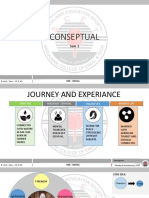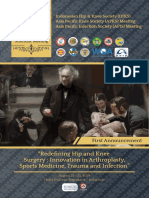Formulation of Research Question: Intech Chater
Formulation of Research Question: Intech Chater
Uploaded by
Dhruti ShahOriginal Description:
Original Title
Copyright
Available Formats
Share this document
Did you find this document useful?
Is this content inappropriate?
Report this DocumentCopyright:
Available Formats
Formulation of Research Question: Intech Chater
Formulation of Research Question: Intech Chater
Uploaded by
Dhruti ShahCopyright:
Available Formats
Formulation of Research Question
As per my parameter for the Dharampur
1) History of Dharampur
2) Dharampur tourism purpose
3) Dharampur skills
INTECH CHATER
The objective of conservation is to maintain the significance of the architectural
heritage or site. the historic precincts of cities and their relationship to the natural
environment. It also includes culturally significant modern buildings and towns. The
intangible heritage includes the extant culture of traditional building skills and
knowledge, rites and rituals, social life and lifestyles of the inhabitants, which
together with the tangible heritage constitutes the ‘living’ heritage. Both tangible
and intangible heritage, and especially the link between them, should be conserved.
architectural heritage exists in fragments, it is necessary to conserve it, even in part,
as representative of a historic past. conserving unprotected architectural heritage
offers the opportunity to use indigenous practices.
1) What to conserve will, therefore, be determined by those strategies of
conservation AREA OF INTEREST DHARAMPUR
2) What is accommodate the imperatives of development and the community
while seeking economically to achieve maximum protection values of the
architectural heritage and site.
integrate unprotected heritage and sites into daily social life by balancing their needs
so that neither overshadows the other. The visual created by advertisement boards,
signage, hanging electric cables, air conditioning units, dish antennas, etc. must be
carefully controlled to enhance the visual character of the architectural heritage and
site. Additions of street furniture, pavement material, lighting, signage, etc. can add
to the experience and appreciation of the heritage. In this respect the objectives of
conservation can mediate even new buildings or neighbourhoods by requiring them
to make reference to the old by employing elements, methods and devices
characterizing the architectural heritage of the area so that the new is linked with
the old. It is an effective strategy to conserve architectural heritage, particularly by
using traditional craftspeople in the process. effect on the local context, and must
conform to the carrying capacity and vulnerability of the architectural heritage. the
extent possible, engage traditional materials, skills and knowledge in the process.
the original internal functional characteristics of the building or site, its external
image must be retained.
RBSA NAME: RUCHIPATEL E.NO : 74- B SUB: RSM
Association with events, activities or patterns.
Association with important persons, including ordinary people who have made
significant contribution to India’s living heritage.
Distinctive physical characteristics of design, construction or form, representing
the work of a master craftsperson.
Potential to yield important information, such as socio-economic history. Railway
stations, town halls, clubs, markets, water works etc.
It must aim to convey the meaning of the heritage in the most effective manner.
reconstruction/ rebuilding can provide the impetus to develop a parallel market for
local buildings materials and new opportunities for the use of alternative systems of
building.
Local material and traditional technology
The use of local materials and traditional technologies must invariably be preferred.
Their choice must be based on the availability of traditional knowledge systems. It is
necessary to recognize that the use of certain traditional building materials may be
inadvisable on account of the damage this can cause to the natural ecological
systems.
AREA OF INTEREST DHARAMPUR
The Impacts of Tourism By Glenn Kreag
1. Economic
2. Environmental
3. Social and cultural
4. Crowding and congestion
5. Services
6. Taxes
7. Community attitude
Environmental
Area with high value natural
resources, like lakes waterfalls,
monuments, unique flora and fauna,
and great scenic beauty attract
tourists and new residents who seek
emotional and spiritual connection
with nature. Because these people
value nature, selected natural
environments are preserved,
protected and ecological decline.
Lands that be developed can generate
income by accommodating the
recreational activities of visitor.
Tourist income often makes it possible
to preserve and restore
historic buildings and monuments.
Social and Cultural
Crowding and Congestion
historic buildings and monuments.
historic buildings and monuments.
Activities
Educational, cultural, and historical tourism often has lower social and
environmental impact.
Recreational activities may have a greater impact on the environment.
Entertainment activities may conflict with the social values of local
residents.
Warli painting
There are a lot of tribute who resides in village of dharampur. the tribal art like
bamboo art and warli painting are the crafts and art found here.
Currently there is a lack of infrastructure and knowledge about the diversity of art
existing in this part of the world which do not allow them to explore the
possibilities of creating different things from the available resources. This limits
them into the same traditional art products which does not give economic benefits
to its capabilities.
This proposal aims to provide a platform that should create awareness among the
people and allow them to learn and explore different kinds of art or direction in
which their local art could be used. It can be a place where their art work will be
showcased to the society and could add to their economic benefits. It could create
a place where peoplehistoric
learn from each other.
buildings and monuments.
Conclusion
Directing tourism growth toward local needs, interests, and limits can greatly
enhance tourism ’s value to the community and help create a sustainable industry.
Many small communities have the skills and resources for successful tourism
development. Creating a local tourism industry is not a daunting task, but making
tourism really "fit" the community requires work.
Thus it could act as a great place to make people aware about art.
This place aim to act as a bridge between the rawness of local art skills and
knowledge of artist.
You might also like
- 660 Rev 29Document1,110 pages660 Rev 29truckman1000100% (4)
- Socio-Cultural Basis of Design in CommunitiesDocument44 pagesSocio-Cultural Basis of Design in CommunitiesClark Vince Caezar Afable100% (4)
- Lesson 5 - Assisting in Establishing RoutinesDocument6 pagesLesson 5 - Assisting in Establishing RoutinesSheena Cruzado78% (9)
- SCIQuestions CaseStudyKeyDocument4 pagesSCIQuestions CaseStudyKeyDeez NutsNo ratings yet
- Unit - 1 PDFDocument18 pagesUnit - 1 PDFsrikavi bharathiNo ratings yet
- Krakov Charter 2000Document5 pagesKrakov Charter 2000danvcoNo ratings yet
- Heritage Tourism: Safeguarding The Past by Making It Relevant TodayDocument28 pagesHeritage Tourism: Safeguarding The Past by Making It Relevant TodayGlory Jane BernardinoNo ratings yet
- Why Heritage Is An Important Community AssetDocument3 pagesWhy Heritage Is An Important Community AssetMiguel A. González LópezNo ratings yet
- Strategy Game Programming With Directx 9.0 PDFDocument558 pagesStrategy Game Programming With Directx 9.0 PDFMichael ButlerNo ratings yet
- X-Rated Hardcore Erotica 5 by Darren G. BurtonDocument3 pagesX-Rated Hardcore Erotica 5 by Darren G. BurtonKazi NawshadNo ratings yet
- Eas Multipars ModelDocument66 pagesEas Multipars ModelLUCIANO LIMANo ratings yet
- Architecture ConservationDocument5 pagesArchitecture ConservationAman Raj MajhiNo ratings yet
- UNIT - 1 ConservationDocument18 pagesUNIT - 1 ConservationSanjay Durai100% (1)
- Heritage Importance in SocietyDocument5 pagesHeritage Importance in SocietyJasmin YadavNo ratings yet
- Architectural ConservationDocument17 pagesArchitectural ConservationMayank Bansal100% (1)
- Yogesh - InTACH CharterDocument9 pagesYogesh - InTACH CharterYogeshNo ratings yet
- Architectural Conservation UNIT I & IIDocument21 pagesArchitectural Conservation UNIT I & IIAnishma Ayyappan100% (2)
- Socio Cultural Basis of Design in CommunitiesDocument44 pagesSocio Cultural Basis of Design in CommunitiesUniqueQuiverNo ratings yet
- Heritage NotesDocument4 pagesHeritage NotesArmay ManaliliNo ratings yet
- Intach CharterDocument12 pagesIntach CharterRenuka UNo ratings yet
- Group 3 - Research PaperDocument29 pagesGroup 3 - Research PaperJasmine SioNo ratings yet
- Cultural HeritageDocument2 pagesCultural HeritagejamesemmanueldupitasNo ratings yet
- Heritage Tourism NotesDocument3 pagesHeritage Tourism NotesGrace PlatinoNo ratings yet
- Architectural Conservation Unit 1Document18 pagesArchitectural Conservation Unit 1Anishma Ayyappan100% (3)
- Eco-Tourism and ArchitectureDocument5 pagesEco-Tourism and ArchitectureShreesh JagtapNo ratings yet
- Cultural Landscape ConservationDocument12 pagesCultural Landscape ConservationZoran PavlovNo ratings yet
- Cultural CenterDocument2 pagesCultural Centervica.babate.cocNo ratings yet
- Travel and Tourism ManagementDocument36 pagesTravel and Tourism ManagementmillyNo ratings yet
- Architectural EnvironmentalDocument13 pagesArchitectural EnvironmentalIEREK PressNo ratings yet
- Thesis Topic - Synopsis: Theme - TourismDocument5 pagesThesis Topic - Synopsis: Theme - TourismAyana GeorgeNo ratings yet
- Dissertation: SynopsisDocument10 pagesDissertation: Synopsisdeepshikha purohitNo ratings yet
- Cultural Heritage MGT - Chapter 5Document42 pagesCultural Heritage MGT - Chapter 5nore lilefilih eyesuseNo ratings yet
- Moral Education AnswersDocument14 pagesMoral Education Answerssahein.mallaNo ratings yet
- Heritage ConservationDocument6 pagesHeritage ConservationsamNo ratings yet
- Broad Area of Intrest: Study The Endowment Wealth of MysoreDocument13 pagesBroad Area of Intrest: Study The Endowment Wealth of MysoreChaitra jpNo ratings yet
- Urban Cultural Landscape: Unit IvDocument7 pagesUrban Cultural Landscape: Unit IvbalaNo ratings yet
- International Cultural Tourism CharterDocument5 pagesInternational Cultural Tourism CharterMaggie SrniNo ratings yet
- Cultural LandscapeDocument140 pagesCultural LandscapeKannamma DorairajNo ratings yet
- Conservation of CultureDocument10 pagesConservation of CulturestuartinsandeepNo ratings yet
- Eco TourismDocument25 pagesEco TourismIndah Dwi CahayanyNo ratings yet
- Case Study - Nizamuddin Urban Renewal - 26-06-21Document23 pagesCase Study - Nizamuddin Urban Renewal - 26-06-21Nikitha G SNo ratings yet
- Historic Area AssessmentDocument41 pagesHistoric Area AssessmentMythili MadhuNo ratings yet
- Urban Conservation and Its Role in Urban Design: Assignment-4Document11 pagesUrban Conservation and Its Role in Urban Design: Assignment-4juveriaNo ratings yet
- Tourism, Residents Agent Practice and Traditional Residential Landscapes at A Cultural Heritage Site: The Case Study of Hongcun Village, ChinaDocument21 pagesTourism, Residents Agent Practice and Traditional Residential Landscapes at A Cultural Heritage Site: The Case Study of Hongcun Village, ChinaReyziel BarganNo ratings yet
- Kitsch and Cultural TourismDocument3 pagesKitsch and Cultural TourismArkantos TirbaNo ratings yet
- Planning For Urban Heritage Places - Reconciling Conservation, Tourism, and Sustainable DevelopmentDocument14 pagesPlanning For Urban Heritage Places - Reconciling Conservation, Tourism, and Sustainable DevelopmentijustclickmycameraNo ratings yet
- Adaptive Reuse and Authenticity Promoting Urban CoDocument18 pagesAdaptive Reuse and Authenticity Promoting Urban CoRoldan VerzosaNo ratings yet
- Methodological Approach Towards Reliving Katra A Cultural Cluster For TourismDocument7 pagesMethodological Approach Towards Reliving Katra A Cultural Cluster For TourismAnoop SharmaNo ratings yet
- Vernacular Submission Karan, Daman, Harmahtab PDFDocument12 pagesVernacular Submission Karan, Daman, Harmahtab PDFYACHIKA SHARMANo ratings yet
- Heritage: Cultural Heitage Natural HeritageDocument4 pagesHeritage: Cultural Heitage Natural Heritagedeepshikha100% (3)
- En Ooru ProjectDocument59 pagesEn Ooru Projectadilshanumm101No ratings yet
- Challenges in Developing Ecotourism in The Region of Lake Sentani PapuaDocument11 pagesChallenges in Developing Ecotourism in The Region of Lake Sentani PapuaAdrian Jr.No ratings yet
- For Friday ThesisDocument20 pagesFor Friday ThesisBradley Rome Viloria BaltazarNo ratings yet
- Chapter 1Document21 pagesChapter 1bandhuarushiNo ratings yet
- Review of Related Literature and StudiesDocument9 pagesReview of Related Literature and Studieskaye-Anne MangaringNo ratings yet
- Intangible Cultural Heritage and Development - ICH 2200 Topic D) and E) - MR PendaDocument137 pagesIntangible Cultural Heritage and Development - ICH 2200 Topic D) and E) - MR PendachandapendaNo ratings yet
- De La Torre, M. y Mac Lean, M. The Archaeological Heritage in Mediterranean Region. 1997Document8 pagesDe La Torre, M. y Mac Lean, M. The Archaeological Heritage in Mediterranean Region. 1997Trinidad Pasíes Arqueología-ConservaciónNo ratings yet
- Importance of Vernacular ArchitectureDocument23 pagesImportance of Vernacular ArchitectureRavnish Batth94% (16)
- Synopsis Redefining Nature A Dynamic Exploration of ArchitecDocument4 pagesSynopsis Redefining Nature A Dynamic Exploration of ArchitecAreeba SiddiquiNo ratings yet
- Heritage-Tourism-Reviewer 3Document11 pagesHeritage-Tourism-Reviewer 3Neekah JoyNo ratings yet
- Heritage ManagementDocument7 pagesHeritage ManagementaadyaagrawalNo ratings yet
- 71 1525 1 PBDocument3 pages71 1525 1 PBSimona GeorgianaNo ratings yet
- r2 d7 Adaptive ReuseDocument24 pagesr2 d7 Adaptive Reusearnie de pedroNo ratings yet
- On The Sustainability of LocalDocument32 pagesOn The Sustainability of LocalAnanya MishraNo ratings yet
- Charter of Cracow 2000Document10 pagesCharter of Cracow 2000xuefeng zhuNo ratings yet
- Qustion 1Document12 pagesQustion 1Dhruti ShahNo ratings yet
- Tourism and The City:: Positive or A Negative ImpactsDocument9 pagesTourism and The City:: Positive or A Negative ImpactsDhruti ShahNo ratings yet
- Why There Is A Need of Introduction of Renaissance Movement? Enumerate The Various Important Features of Renaissance Architecture?Document14 pagesWhy There Is A Need of Introduction of Renaissance Movement? Enumerate The Various Important Features of Renaissance Architecture?Dhruti ShahNo ratings yet
- Name: Issac Bijoy V. EN. NO: 02Document11 pagesName: Issac Bijoy V. EN. NO: 02Dhruti ShahNo ratings yet
- Name-Ayushi Lad EN - NO-201603101710031 Sub-Rsm Sem-Iv-ADocument4 pagesName-Ayushi Lad EN - NO-201603101710031 Sub-Rsm Sem-Iv-ADhruti ShahNo ratings yet
- Name-Ayushi Lad EN - NO-201603101710031 Sub-Rsm Sem-Iv-ADocument8 pagesName-Ayushi Lad EN - NO-201603101710031 Sub-Rsm Sem-Iv-ADhruti ShahNo ratings yet
- Conseptual: AR 1980 Sanyam ShahDocument13 pagesConseptual: AR 1980 Sanyam ShahDhruti ShahNo ratings yet
- Symmetry and BalanceDocument13 pagesSymmetry and BalanceDhruti ShahNo ratings yet
- 1 - Study Area PDFDocument3 pages1 - Study Area PDFDhruti ShahNo ratings yet
- Hazardous Area Classifications and Protections by EmersonDocument8 pagesHazardous Area Classifications and Protections by EmersonShahram GhassemiNo ratings yet
- First AnnouncementDocument16 pagesFirst AnnouncementDewa BraÇika Damma PrasadaNo ratings yet
- Press Release On Class Action Against The City of Memphis and MLGWDocument1 pagePress Release On Class Action Against The City of Memphis and MLGWFOX13 MemphisNo ratings yet
- Autoduel Tales - The Fiction of Car Wars (Preview) - Steven Marsh (Ed) (SJG30-7157) (1983-1993, 2020)Document9 pagesAutoduel Tales - The Fiction of Car Wars (Preview) - Steven Marsh (Ed) (SJG30-7157) (1983-1993, 2020)Mr xv100% (1)
- Wing Structure Design ProjectDocument132 pagesWing Structure Design ProjectKhoinguyen NguyenNo ratings yet
- Space Factors AreaDocument4 pagesSpace Factors AreajadeNo ratings yet
- Practice Test Class 6Document10 pagesPractice Test Class 6Mahmood A. SabriNo ratings yet
- Chapter 06Document43 pagesChapter 06richaNo ratings yet
- Quiz-1 Course: HRM-380Document6 pagesQuiz-1 Course: HRM-380NahidulNo ratings yet
- SECO 02-2022-04 UpdateDocument13 pagesSECO 02-2022-04 UpdateJoachim HagegeNo ratings yet
- ESHB 1001834 Reduced Size PDFDocument512 pagesESHB 1001834 Reduced Size PDFJaswinder Pal BehlNo ratings yet
- Settlement For Cohesive SoilDocument9 pagesSettlement For Cohesive SoilQuach TuanNo ratings yet
- Domino Lesson PlanDocument4 pagesDomino Lesson Planapi-372539116No ratings yet
- LP For Final DemoDocument8 pagesLP For Final DemoAiah Rica SumalinogNo ratings yet
- Canet v. DecenaDocument1 pageCanet v. DecenaEmelson Maranes100% (2)
- Alen Breathe Smart Air Purifier ManualDocument11 pagesAlen Breathe Smart Air Purifier ManualDustin HoangNo ratings yet
- Info 3400 StudyDocument114 pagesInfo 3400 StudyBobby LottNo ratings yet
- HRIS Metrics Case StudyDocument2 pagesHRIS Metrics Case Studysupriya sonkusareNo ratings yet
- Bijay Kumar MohantyDocument4 pagesBijay Kumar Mohantybmohanty97No ratings yet
- Country CompetitivenessDocument23 pagesCountry CompetitivenessAbhinav ChauhanNo ratings yet
- Geologic Time: Correlation and Dating of The Rock RecordDocument88 pagesGeologic Time: Correlation and Dating of The Rock RecordZul AtfiNo ratings yet
- Markting-Strategy Paytm Pallavi Jawale ProjectDocument91 pagesMarkting-Strategy Paytm Pallavi Jawale ProjectAniket YadavNo ratings yet
- Schöll - Lens - Instability Phenomena in Interconnected Power SystemsDocument7 pagesSchöll - Lens - Instability Phenomena in Interconnected Power Systems程浩真No ratings yet
- Curriculum Vate MelbinDocument3 pagesCurriculum Vate MelbinMelbinNo ratings yet


































































































